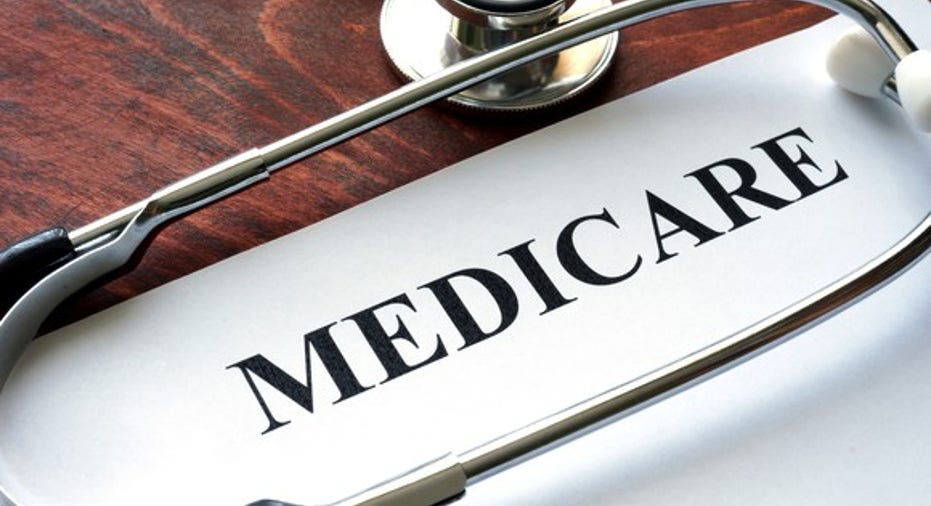Medicare in 2017: 5 Numbers Everyone Should Know

When you decide to stop working, the odds are good that Medicare will be a critical part of your financial plan to cover your healthcare expenses. Medicare doesn't cover all of your costs of staying healthy, but with most people becoming eligible for the program when they turn 65, joining the more than 56 million Americans who already get Medicare proves to be the best choice in most cases. Below, we'll look at some of the simple numbers that you should know about Medicare coverage.
Image source: Getty Images.
10 years
Medicare plays a key role in financial security for seniors, but not everyone is eligible. In order to get Medicare coverage, including free Part A hospital insurance without monthly premiums, you need to have 40 credits under the Social Security program. With each credit requiring $1,300 of earned income in 2017, most people who work are able to earn enough to get the maximum of four credits per year. Therefore, it takes most people 10 years to become eligible for Medicare.
Note that Medicare is still available to many people even if they don't meet these requirements. Those who are married can participate if their spouse meets the work requirement. Moreover, those with fewer credits can participate by paying Part A monthly premiums. For those with fewer than 30 credits, the premium cost is $413 per month in 2017. However, most people find that applying for Medicare is not only available but also as easy as going to this Social Security website about Medicare benefits and clicking on the Apply for Medicare Only button.
$1,316
No matter whether you pay a premium for Part A hospital coverage, you do have to pay a deductible for inpatient hospital care. For 2017, that amount will rise to $1,316, up $28 from its 2016 level.
The deductible is the only thing patients pay for the first 60 days of covered hospital expenses, with Medicare picking up the entire daily cost of inpatient care. Beyond that, participants must also pay an additional $329 per day for the 61st to 90th days of their hospital stay as a required copayment. Beyond 90 days, participants must use up their 60 lifetime reserve days, and the copayment amount doubles to $658 per day. All told, Medicare covers a huge amount of hospital expenses even once these copayments start taking effect.
$134 and $109
Medicare Part B medical coverage charges participants a monthly premium. However, what that premium is depends on how long you've had Medicare and whether you have your premiums withheld directly from your Social Security benefits.
In 2017, new enrollees to Medicare and those whose premiums are paid by state Medicaid programs will pay $134 per month for Medicare Part B. That's because healthcare costs have risen, and so annual cost increases have pushed the premium up from the $121.80 per month that new enrollees paid in 2016.
However, many Medicare participants are covered by what's known as the hold-harmless provision. This takes effect when there are little or no increases in Social Security benefits due to cost-of-living adjustments, and it limits the possible rise in Medicare costs. Therefore, for the average Medicare participant who has been in the program for more than a couple of years, the Part B premium will be $109 per month in 2017.
$3,700
Medicare Part D provides prescription drug plans, which cover a substantial portion of pharmaceutical costs. However, most plans under Part D have a coverage gap. Because this feature of Part D provides no benefits for a certain expense amount in between the initial coverage and the catastrophic coverage maximum out-of-pocket provisions, this gap is also known as the donut hole. For 2017, the coverage gap at $3,700, representing the total amount that you and your plan pays for drugs during the year.
Once you hit the coverage gap, you're responsible for covering 40% of the plan's cost for brand-name drugs. The plan itself pays 10%, and the manufacturer of the drug covers the other 50%. For generic drugs, you'll pay 51%, and Medicare pays the remaining 49%. With brand-name drugs, even though you pay only a limited amount, you get credit for having paid the drugmaker's share as well for purposes of triggering out-of-pocket maximums. Once you hit that out-of-pocket limit -- which is $4,950 for 2016 -- your plan goes back to covering the vast majority of the cost of your prescription drugs.
Medicare's provisions aren't always simple. But knowing these basic numbers can help you understand the program a lot better. Whether your or a loved one has healthcare coverage under the program, you owe it to yourself to know as much as you can about Medicare in order to make the best decisions possible.
The $15,834 Social Security bonus most retirees completely overlook If you're like most Americans, you're a few years (or more) behind on your retirement savings. But a handful of little-known "Social Security secrets" could help ensure a boost in your retirement income. For example: one easy trick could pay you as much as $15,834 more... each year! Once you learn how to maximize your Social Security benefits, we think you could retire confidently with the peace of mind we're all after.Simply click here to discover how to learn more about these strategies.
Try any of our Foolish newsletter services free for 30 days. We Fools may not all hold the same opinions, but we all believe that considering a diverse range of insights makes us better investors. The Motley Fool has a disclosure policy.



















